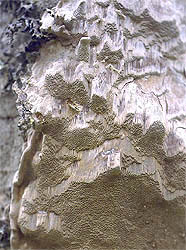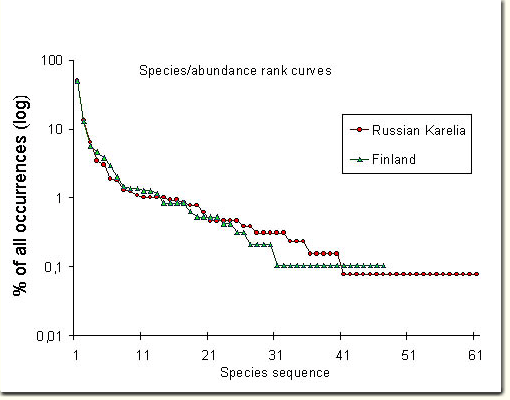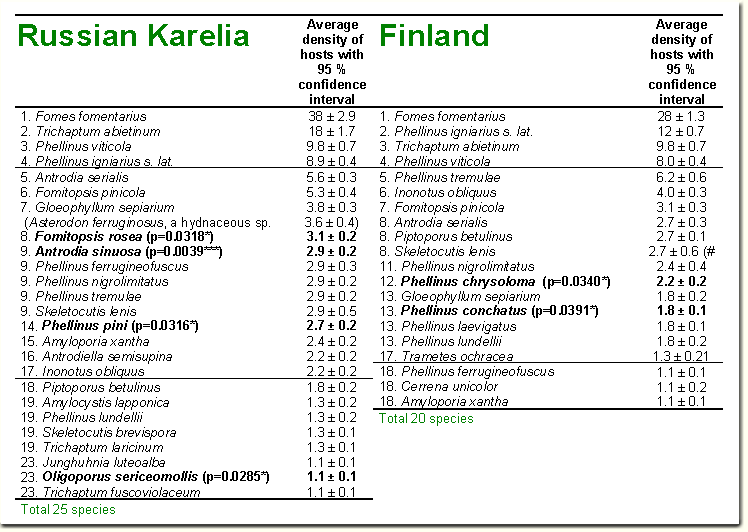|
Mariko Lindgren Finnish Museum of Natural History, Mycology Division P.O. Box 47 00014 University of Helsinki FINLAND Email: mariko.lindgren@helsinki.fi |
 |
|
Mariko Lindgren Finnish Museum of Natural History, Mycology Division P.O. Box 47 00014 University of Helsinki FINLAND Email: mariko.lindgren@helsinki.fi |
 |
Human activities have caused fragmentation and degradation of habitats, which in turn have a negative effect on the abundance and survival of many species. One method for studying these changes with empirical data is to compare fragmented or degraded areas with an intact area. For Fennoscandian forests such highly natural reference landscapes can be found in northwestern Russian Karelia, near the Finnish border (e.g. Gromtsev 1998).
Finnish state owned old-growth forest areas - including the existing protection areas - were chosen for the comparison, since in preserving forest-dependent biodiversity in Finland these areas make up the backbone of the conservation network. The ability of the existing old-growth forest areas to sustain natural communities of wood-inhabiting fungi has been stated to be of great importance in the survival of these species on a regional level (Rassi et al.1996). Studies on the efficiency of the protection area network to serve this goal has been called for by, e.g., Rassi et al. (1996) and is closely related to the need to evaluate the state of biodiversity in Finnish forests in general (Kangas et al.1998).
Kainuu and Koillismaa provinces were selected for the study, since they are biogeographically very similar to the control area in northwestern Russian Karelia (Ahti et al. 1968).
Randomly placed study plots are supposed to represent the dominant forest structures and vegetational units of the study areas. If a statistically significant difference in the studied variables is detected between the Finnish old-growth forests and the Russian natural landscapes by random sampling, a character which has a great importance in polypore communities in this scale has probably been caught.
The following questions are addressed in my study:
1) What kinds of polypore communities occur in the Russian Karelian study area?
2) Are there any differences in the polypore species richnesses or community compositions between the two study areas: unfragmented primeval forests of northwestern Russian Karelia and old-growth forests of the Kainuu and Koillismaa provinces in Finland? What are the main characteristics of these possible differences?
Study areas and selection of study plots
Russian Karelian study area is situated in the Muechersky and Kostamuksha Districts, in a primeval forest belt next to the Finnish border. By using satellite images I subjectively outlined three selection areas of 130 square kilometres (Fig. 1.). One of them is situated in the inventory area of the planned Kalevala National Park (Gromtsev 1998), and one belongs to the unprotected primeval forest southeast of the Kostamuksha Strict Nature Reserve. To allow easy access, the third selection area stretches along a new logging road just south of the planned Kalevala National Park. The Russian gridlines limit the selection areas so that only full square kilometres are included. To avoid human impact, areas near villages and bigger waterways were excluded. Each selection area consists of and is surrounded by continuous, mainly unfragmented primeval forest-mire mosaics of several hundreds of square kilometres. In each three selection areas, three study plots were randomly chosen (see Lindgren 1999).
Finnish study area, the municipalities of Posio, Kuusamo, Taivalkoski, Suomussalmi and the northern part of the municipality of Kuhmo, form a landscape fragmented by modern forestry. The size of the still existing old-growth forests and undrained mire areas varies from tiny fragments to about one hundred square kilometres in size. Nine study plots of 0.5 hectares were randomly selected on the areas belonging to the old-growth-forest inventory programme of the Finnish Forest and Park Service (Kumpulainen et al. 1997) (Fig. 1.). Since the boundaries of these areas have changed during the inventory process, the situation of spring 1995 was used. Inventory areas include existing protection areas.
In both Finland and Karelia, the study plots of 0.5 hectares are made out of two subplots of 50 m x 50 m. To include natural variation of forest stands, including edge-effects, there were no selection criteria considering the nutritious level or tree species composition of the sites. The only criterium was that no more than one third of a single subplot could comprise mire or swamp with only thin tree cover. The selection procedure is explained at full detail in Lindgren (1999).
Field methods
From the study plots all living trees and all fallen and standing dead trees with breast height diametre 5 cm or more and length over 1 meter were investigated. On each trunk all polypore species present were recorded. Some other aphyllophorous fungi, classified as indicators of old-growth or virgin forest by Kotiranta and Niemelä (1996), were also recorded. They are Asterodon ferruginosus Pat., Gloiodon strigosus (Schwein.: Fr.) P. Karst., Crustoderma dryinum (Berk. & M. A. Curtis) Parmasto, Phlebia centrifuga P. Karst., Laurilia sulcata (Burt) Pouzar and Cystostereum murrayi (Berk. & M. A. Curtis) Pouzar. Of the threatened aphyllophorous fungi (Kotiranta & Niemelä 1996), the species Kavinia alboviridis (Morgan) Gilb. & Budington and Radulodon eriksonii Ryvarden were also looked for. Species with perennial basidiocarps were excluded from the analysis of this study if only dead basidiocarps were present on a host trunk: such an individual was considered to be dead at the moment of study.
Altogether 1566 occurrences of wood inhabiting polypores and 21 occurrences of other species of indicator fungi were recorded. In all 72 species were identified, of which 67 were polypores and 5 other fungal indicator species. Of the recorded species, 33 were found from both areas, 27 only from Russian Karelia and 12 species only from Finland. Summarised data on polypore species richness on the study plots in Finland and Russian Karelia is presented in Figure 2.
 |
Figure 2. Summarised data on the polypore species richnesses on the Finnish and Russian Karelian study plots. |
Of the 72 species found, 19 have been listed in the Red Data Book of Finland, of them 3 as vulnerable, 5 as care demanding and 11 as rare (Kotiranta & Niemelä 1996). Species classified as threatened were present in all study plots in the Russian Karelia, and in 56 % of the plots in Finland. All three vulnerable species were found in the Russian Karelian sites only. Of the species classified as care demanding and rare, 2 were found in both study areas, 9 only in Russian Karelia and 5 only in Finland. Summarised data on the number of threatened species on both study areas is shown in Figure 3.
 |
Figure 3. Summarised data on the number of threatened species on the Finnish and Russian Karelian study plots. Red Data -classification according to Kotiranta and Niemelä (1996). |
Species/abundance rank curves for the two study areas are plotted in Figure 4. Counted Q-statistics for the two areas are 13.9 for Russian Karelia and 11.1 for Finnish old-growth forests.
 |
Figure 4. Species/abundance rank plots for the two study areas. |
Species that had an average population density of more than one host tree per hectare and occurred on more than one study site in both Finland and Russian Karelia are listed in Table 1.
 |
| Table 1. Species that had an average population density of more than one host tree per hectare and occurred on more than one study site in both Finland and Russian Karelia, nomenclature according to Niemelä (1998). Species that show greater abundance in the study area in question than in the other study area with a risk value less than 5 % are printed in bold and the p-value is given in parentheses (2-tailed Mann-Whitney U-test). After the species name an average population density (host trees per hectare) in the study plots of a given area is given (with 95 % confidence interval). #) = Occurred only on one study site in Finland. |
Since the two study areas have very similar climate and tree species compositions (e.g. Ahti et al. 1968), I suppose that the polypore communities are determined by other variables than the climatic distribution limits of any of the species. Differences are a summary of different abilities of the two studied study areas to sustain a certain polypore flora, polypore populations and community structures.
In addition to having a higher small-scale species richness, the unfragmented natural forests in Russian Karelian landscape seem to host more dense populations of conservationally valuable species than what the Finnish old-growth forests in Kainuu and Koillismaa have. When evaluating the extinction risks of these species in Finland, this possible reduction of their densities within the existing old-growth forests and protected areas should be kept in mind. I can see two main reasons for the possible decline: reduced number of host trees within forest areas - mainly caused by selective loggings - and habitat fragmentation.
Ahti, T., Hämet-Ahti, L. & Jalas, J. 1968: Vegetation zones and their sections in northwestern Europe. - Annales Botanici Fennici 5: 169-211.
Gromtsev, A. N. (ed.) 1998: Inventory of natural complexes and ecological feasibility study of Kalevala National Park. - Forest Research Institute, Karelian Research Centre, Russian Acad. of Sciences, Petrozavodsk. 57 pp. (preprint)
Kangas, P., Jäppinen, J. P., von Weissenberg, M. & Karjalainen, H. 1998: National action plan for biodiversity in Finland, 1997-2005. - Ministry of Environment, Helsinki. 127 pp.
Kumpulainen, K., Itkonen, P., Jäkäläniemi, A., Leivo, A., Meriruoko, A. & Tikkanen, E. 1997: Pohjois-Suomen vanhojen metsien inventointimenetelmä (Northern Finland's Old Forest Inventory Programme). - Metsähallituksen Luonnonsuojelujulkaisuja A 72:1-107.
Kotiranta, H. & Niemelä, T. 1996: Uhanalaiset käävät Suomessa. Threatened polypores in Finland. Second revised edition. - Suomen ympäristökeskus, Helsinki. 184 pp.
Lindgren, M., 1999: Polypore (Basidiomycetes) species richness and community composition in old-growth boreal forests of northeastern Finland and adjacent Russian Karelia. - Master's thesis, University of Helsinki, Faculty of Science, Systematic-ecological botany. 52 pp.
Niemelä, T. 1998: Guide to the polypores of Finland, 11th revised edition. - Botanical Bulletins of the University of Helsinki 152.
Rassi, P., Itkonen, P., Lindholm, T. & Salminen, P. 1996: Vanhojen metsien suojelu Pohjois-Suomessa. Vanhojen metsien suojelutyöryhmän osamietintö 3. Protection of old-growth forests in northern Finland; report 3 by the working group for protection of old-growth forests. - Ministry of Environment, Land Use Dept., Helsinki. 108 pp.